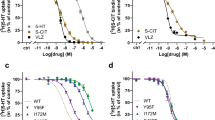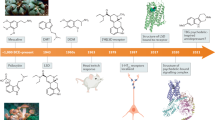Abstract
THE discovery in 1957 of the therapeutic effect of imipramine in endogenous depression1 stimulated a search for other substances with similar properties, and several drugs which are structurally closely related to imipramine, known collectively as the tricyclic antidepressants, have become available2. The spectrum of antidepressant effects of these drugs is fairly uniform, although some possess tranquillizing activity, which is useful for treating patients whose depression is complicated by agitation3,4. But these substances have side effects which stem partly from anticholinergic and antihistaminic properties5. In the past 5 yr attempts have been made to depart from the tricyclic structures, and antidepressant activity has been claimed for iprindole6, IN 1060 (ref. 7), thiazesim8 and other compounds, but it is too early to assess their place in the therapy of depression.
This is a preview of subscription content, access via your institution
Access options
Subscribe to this journal
Receive 51 print issues and online access
$199.00 per year
only $3.90 per issue
Buy this article
- Purchase on Springer Link
- Instant access to full article PDF
Prices may be subject to local taxes which are calculated during checkout
Similar content being viewed by others
References
Kuhn, R., Schweiz. Med. Wochschr., 87, 1135 (1957).
Biel, J. H., Drugs Affecting the Central Nervous System, 2, (edit. by Burger, A.), 61 (Arnold, London, 1968).
Ayd, F. J., Dis. Nerv. Syst. 26, 719 (1965).
Simpson, G. M., and Salim, T., Curr. Ther. Res., 7, 661 (1965).
Sulser, F., Bickel, M. H., and Brodie, B. B., J. Pharmacol. Exp. Ther., 144, 321 (1964). Cairncross, K. D., Gershon, S., and Gust, I. D., J. Neuropsychiat., 4, 224 (1963). Bogdanski, D. F., Sulser, F., and Brodie, B. B., J. Pharmacol. Exp. Ther., 132, 176 (1961). Costa, E., Garattini, S., and Valzelli, L., Experientia, 16, 461 (1960). Domenjoz, R., and Theobald, W., Arch. Intern. Pharmacodyn., 20, 450 (1959). Rathbun, R. C., and Slater, I. H., Psychopharmacologia, 4, 114 (1963).
El Deiry, N. K., Forrest, A. D., and Littmann, S. K., Brit. J. Psychiat., 113, 999 (1967). Johnson, J., and Maden, J. G., Clin. Trials J., 4, 787 (1967).
Sletten, I. W., Pichardo, X., and Gershon, S., Curr. Ther. Res., 7, 609 (1965).
Freeman, H., Otkem, M. R., Kristofferson, M. W., and Gorby, C. K., Curr. Ther. Res., 7, 655 (1965).
Walker, G. N., Smith, R. T., and Weaver, B. N., J. Med. Chem., 8, 626 (1965).
Author information
Authors and Affiliations
Rights and permissions
About this article
Cite this article
CANAS-RODRIGUEZ, A., LEEMING, P. N-Phenyl Indoline Derivatives—a New Class of Antidepressant Agents. Nature 223, 75–76 (1969). https://doi.org/10.1038/223075a0
Received:
Issue Date:
DOI: https://doi.org/10.1038/223075a0
Comments
By submitting a comment you agree to abide by our Terms and Community Guidelines. If you find something abusive or that does not comply with our terms or guidelines please flag it as inappropriate.



